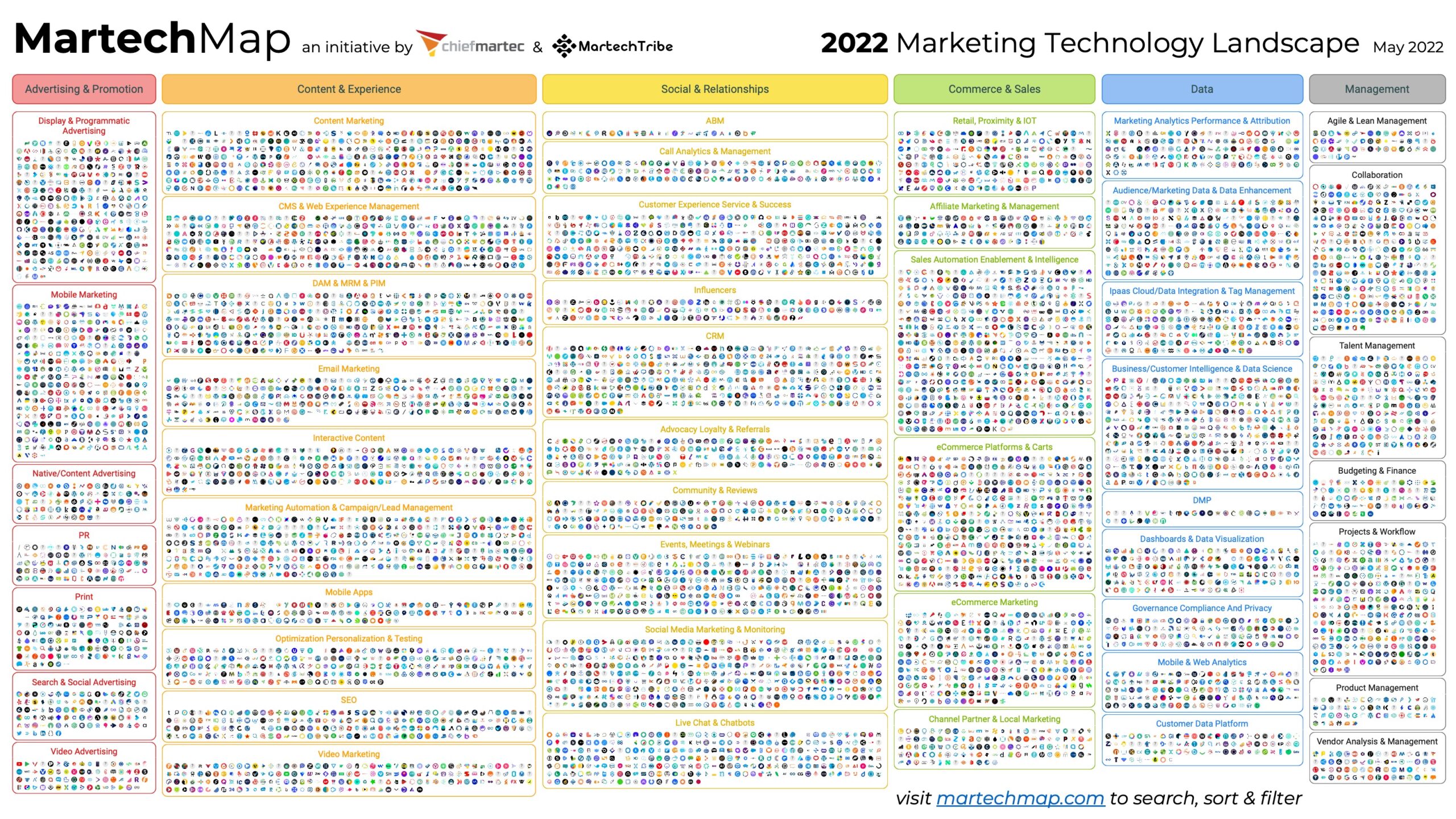With the martech industry estimated to be worth $509.8bn according to LXA’s The State of Martech 2022/23 report, there is no better time to sit down with the Godfather of marketing technology, Scott Brinker. Scott primarily made his name – and guaranteed a Wikipedia entry – in 2011 with the release of the martech supergraphic, a visual representation of the technology solutions used in marketing. In 2022, Scott teamed up with MartechTribe to reveal that the number of solutions is now 9,932 — up 24% from 2020. His latest update in December reveals that number hit 10,383.
Scott is now VP of platform ecosystem at HubSpot, and we started by asking about the proudest achievement in his current role.
“Helping to drive HubSpot’s philosophy of a truly open platform ecosystem that helps businesses scale up. This means partners don’t have to pay-to-play and small start-ups have a much greater opportunity to build something brilliant in the marketplace using our tools. A key aspect that has helped make this possible is that we don’t restrict products that may have competitive overlaps with ours. Ultimately, this is all in the service of giving customers freedom of choice: Pick the best products for their business and have them work beautifully together in an organised tech stack.”
Tell us what drew you to marketing technology in the first place
“My parents ran an advertising agency and I was a computer game programmer as a teenager. It used to be that marketing and software engineering were considered opposite ends of the career spectrum. Now, with the internet and the rise of digital marketing and digital customer experiences, those two worlds collided.
“I believe both marketers and developers are creative professionals. I was inspired by the opportunities these two kinds of creative expressions could unlock, and how they could be blended together.”
What was the inspiration behind the supergraphic?
“The old Star Trek meme ‘Damn it, Jim, I’m a marketer not a system architect’ springs to mind here. Going back 15 years ago, many CMOs and other marketing leaders were sceptical of the role of technology in their organisations. They still thought of tech as being a separate role and career path.
“That’s why I put together the first martech landscape in 2011, mapping around 150 different martech products that were popular at the time, to help marketing executives see just how much technology had infiltrated and influenced their profession. These were the tools they were increasingly dependent on to deliver results. They needed to start treating marketing technology and operations as a first-class capability in their organisation.”

How has martech evolved over the past 10 years?
“The most obvious answer is the number of martech products has grown exponentially over the past decade. Our most recent update to the martech landscape database in December had 10,383 vendors. And that’s after a whole bunch of consolidation in the industry over the past few years! And there are other evolutionary changes that are important to recognise.
“What’s more, martech is becoming better integrated, thanks to the rise of platform ecosystems and commitments from vendors to prioritise good integration as a key requirement.
“The user experience (UX) of many martech products has also improved dramatically from earlier generations due to the ‘consumerisation’ of interfaces for business products. UX matters greatly and customers can write you off in a matter of seconds if they don’t find your tech easy to use.
“Finally, more ‘no-code’ features in martech products are enabling non-technical marketers to build digital experiences and process automations without having to rely on backlogged IT staff or expensive external service providers. This means marketers can react fast to industry changes and improve the customer experience almost instantaneously.”
How important is technology in modern marketing?
“How important is code in The Matrix? It *is* The Matrix.
“The world is digital. Every touchpoint marketers have with customers is either purely digital — websites, mobile apps, social media, search engines, CTV — or supported by digital capabilities behind the scenes. And everything digital is orchestrated by software.
“That said, it’s even more important to remember that martech is a set of enabling tools. The real magic is in how marketers wield these tools to create compelling marketing programs, campaigns, and experiences.”
Which media channels do you see as most important and best value when it comes to marketing spend and activity?
“If you’ll forgive me for dodging the question, I believe the real answer is: It depends. Where are your customers? In what context are they receptive to what you can deliver? Where can you achieve effective ROI? Where can you stand out?
“The upside to digital channel fragmentation is that there are a lot of opportunities. Generally speaking, as popular as omnichannel marketing is, I think the best marketers often focus on just a few channels and work to make them the strongest they can be.”
In your opinion, what is the main difference between B2C and B2B marketing?
“One of the main differences is that B2B purchases – at least non-trivial ones – tend to have more stakeholders involved in the buying process. Champions, evaluators, influencers. decision-makers, budget owners, and so on are often involved. Each has their own interests and perceptions that contribute to the collective decision. These can be complex deals and it’s the primary reason that account-based marketing, ABM, became the dominant model of B2B marketing.
“Of course, this is also a fantastic opportunity for marketing and sales teams to get creative and coordinate how they win those deals. It is vital that these teams work together seamlessly to generate sales, or efforts can become lost.
“Conversely, in many B2C marketing scenarios, you can craft your message and experience around the fact that the buying decision is often made by one individual. It can be a much more personal decision which often benefits from leveraging more personalisation in the experience itself.”
And finally, which future marketing trends will become mainstream before too long?
“The hot one right now is generative AI. With projects like DALL-E and ChatGPT, this technology is graduating from being ‘science fair’ projects to showing how they can deliver really significant value to marketers. I think we’re going to see some incredible ways that this technology gets incorporated into the work of mainstream marketing this year.”




